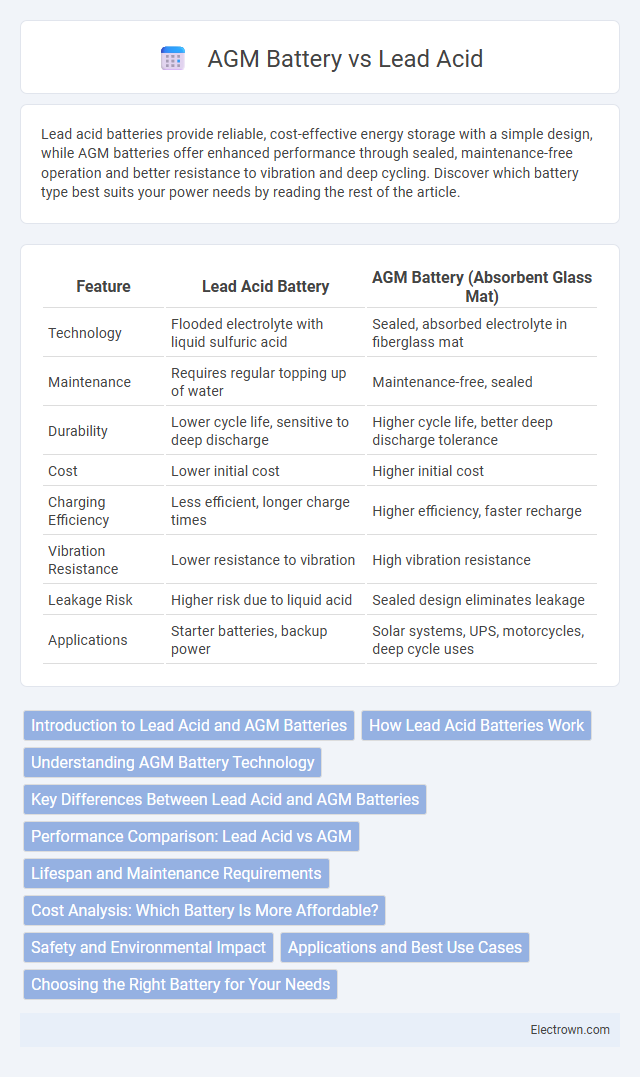Lead acid batteries provide reliable, cost-effective energy storage with a simple design, while AGM batteries offer enhanced performance through sealed, maintenance-free operation and better resistance to vibration and deep cycling. Discover which battery type best suits your power needs by reading the rest of the article.
Table of Comparison
| Feature | Lead Acid Battery | AGM Battery (Absorbent Glass Mat) |
|---|---|---|
| Technology | Flooded electrolyte with liquid sulfuric acid | Sealed, absorbed electrolyte in fiberglass mat |
| Maintenance | Requires regular topping up of water | Maintenance-free, sealed |
| Durability | Lower cycle life, sensitive to deep discharge | Higher cycle life, better deep discharge tolerance |
| Cost | Lower initial cost | Higher initial cost |
| Charging Efficiency | Less efficient, longer charge times | Higher efficiency, faster recharge |
| Vibration Resistance | Lower resistance to vibration | High vibration resistance |
| Leakage Risk | Higher risk due to liquid acid | Sealed design eliminates leakage |
| Applications | Starter batteries, backup power | Solar systems, UPS, motorcycles, deep cycle uses |
Introduction to Lead Acid and AGM Batteries
Lead acid batteries are traditional rechargeable energy storage devices widely used in automotive and industrial applications due to their cost-effectiveness and reliability. Absorbed Glass Mat (AGM) batteries, a type of sealed lead acid battery, feature an advanced design with glass fiber mats that absorb the electrolyte, offering improved spill resistance and enhanced performance. AGM batteries provide better charge acceptance, longer cycle life, and superior vibration resistance compared to conventional lead acid batteries, making them ideal for high-demand environments.
How Lead Acid Batteries Work
Lead acid batteries operate through a chemical reaction between lead dioxide (PbO2) on the positive plate, sponge lead (Pb) on the negative plate, and sulfuric acid (H2SO4) electrolyte, producing electrical energy. During discharge, lead dioxide and sponge lead react with sulfuric acid to form lead sulfate (PbSO4) on both electrodes while releasing electrons that generate electric current. The charging process reverses this reaction, converting lead sulfate back into lead dioxide, sponge lead, and sulfuric acid, restoring the battery's capacity.
Understanding AGM Battery Technology
AGM battery technology uses Absorbent Glass Mat separators that hold the electrolyte in place, preventing spillage and enabling a spill-proof design. These batteries offer superior charge efficiency, lower internal resistance, and enhanced vibration resistance compared to traditional lead acid batteries. AGM batteries also provide longer service life, faster recharge times, and better performance in cold temperatures, making them ideal for automotive and renewable energy applications.
Key Differences Between Lead Acid and AGM Batteries
Lead acid batteries use liquid electrolyte that can spill or evaporate, while AGM (Absorbent Glass Mat) batteries feature a sealed design with electrolyte absorbed in glass mats, providing spill-proof operation. AGM batteries offer faster charging, deeper discharge capabilities, and longer lifespan compared to traditional lead acid models. Your choice depends on application requirements like maintenance, durability, and performance in high-vibration environments.
Performance Comparison: Lead Acid vs AGM
AGM batteries outperform traditional lead acid batteries with higher charge acceptance and faster recharge times, improving overall efficiency in automotive and solar applications. AGM batteries exhibit superior deep cycling capabilities and longer lifespan, supporting more consistent power delivery under demanding conditions. In contrast, lead acid batteries tend to suffer from reduced performance due to sulfation and require more maintenance, making AGM the preferred choice for modern high-performance energy storage.
Lifespan and Maintenance Requirements
Lead acid batteries typically have a lifespan of 3 to 5 years and require regular maintenance such as checking electrolyte levels and cleaning terminals to ensure optimal performance. AGM (Absorbent Glass Mat) batteries offer a longer lifespan, often lasting 4 to 7 years, with minimal maintenance since they are sealed and resistant to spillage. Your choice between these batteries will impact the frequency of upkeep and the overall durability of your power storage solution.
Cost Analysis: Which Battery Is More Affordable?
Lead acid batteries typically offer a lower upfront cost compared to AGM batteries, making them a more affordable option for budget-conscious buyers. However, AGM batteries provide longer lifespan and better performance, which can reduce replacement and maintenance costs over time. Evaluating your specific energy needs and total cost of ownership will help determine which battery offers the best value for your investment.
Safety and Environmental Impact
AGM batteries offer enhanced safety compared to traditional lead acid batteries due to their sealed design, reducing the risk of acid leaks and corrosion, which can harm the environment. Lead acid batteries contain liquid electrolytes that may spill and release hazardous sulfuric acid, posing greater environmental hazards during improper disposal. Choosing AGM batteries can minimize your ecological footprint through safer handling, lower emissions, and better recyclability.
Applications and Best Use Cases
Lead acid batteries are widely used in automotive starters, uninterruptible power supplies (UPS), and renewable energy systems due to their cost-effectiveness and reliable performance under steady loads. AGM batteries, a type of sealed lead acid battery, excel in deep cycle applications such as marine vessels, recreational vehicles, and advanced backup systems where vibration resistance, maintenance-free operation, and superior discharge recovery are critical. Selecting between lead acid and AGM batteries depends on specific demands like cycle life, weight considerations, and environmental conditions.
Choosing the Right Battery for Your Needs
Lead acid batteries offer reliable performance and affordability for basic energy storage, making them ideal for applications with moderate power demands and budget constraints. AGM batteries provide enhanced durability, faster charging, and better resistance to vibration and temperature extremes, suitable for high-performance or frequent cycling scenarios. Understanding your power requirements and usage patterns ensures you select the right battery technology to maximize efficiency and lifespan.
Lead acid vs AGM battery Infographic

 electrown.com
electrown.com